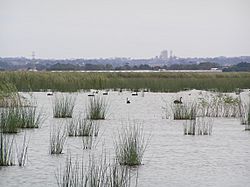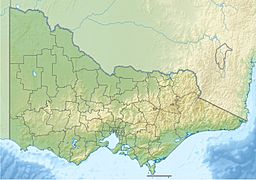Reedy Lake facts for kids
Quick facts for kids Reedy Lake |
|
|---|---|
| Lake Reedy | |

View of lake with black swans
|
|
| Location | Bellarine Peninsula, Victoria, Australia |
| Coordinates | 38°12′21″S 144°25′13″E / 38.20583°S 144.42028°E |
| Type | Intermittent freshwater swamp |
| Primary inflows | Barwon River |
| Primary outflows | Barwon River |
| Basin countries | Australia |
| Surface area | 5.5 km2 (2.1 sq mi) |
| Average depth | 0.5–2 m (1 ft 8 in – 6 ft 7 in) |
Reedy Lake is a special freshwater lake or swamp in Victoria, Australia. It's also known as Lake Reedy. This shallow lake covers about 5.5-square-kilometre (2.1 sq mi) and is found on the Bellarine Peninsula. It's southeast of a city called Geelong. The lake is part of the Barwon River system.
Reedy Lake is an important place for many plants and animals. It's known for its rich plant life and is a home for lots of different waterbirds. Sometimes, thousands of birds gather here to breed.
Contents
Where is Reedy Lake?
Reedy Lake is part of the Lake Connewarre State Game Reserve. This reserve is looked after by Parks Victoria. It's the biggest freshwater swamp in central Victoria. The lake is part of a larger wetland area. This area includes places like Hospital Swamp and Lake Connewarre.
A special gate called a weir controls the water flowing out of the lake. This weir helps manage the water level. Reedy Lake is so important that it's listed under the Ramsar Convention. This means it's a wetland of international importance. It's part of the Port Phillip Bay (Western Shoreline) and Bellarine Peninsula Ramsar Site.
History of Reedy Lake
Thousands of years ago, Reedy Lake was actually part of a big ocean bay. About 6,000 years ago, the sea level changed. Sand dunes then formed a barrier, cutting the lake off from the ocean. The bottom of the lake became covered with clay from the Barwon River.
Before Europeans settled in the early 1800s, the lake was a wetland that changed with the seasons. In summer, it could get salty from groundwater or very high tides. But in winter, river floods would wash out the salt, making it fresh again.
Controlling Water Levels
The first barrier on the Barwon River was built in 1838. This was to provide fresh water for Geelong. In 1899, another barrier was built further downstream. This made Reedy Lake mostly freshwater. It became a place with lots of plants and many waterbirds.
People started to see how special the lake was. In 1935, it was temporarily protected. Later, it became a permanent game reserve. This gave it even more protection. During the 1950s, 60s, and 70s, more work was done. Pipes were added to bring water in from the river. An outlet channel with a flow regulator was also built. These helped control the lake's water levels.
Dealing with Carp
In the early 1990s, the lake faced a problem. The water levels were more permanent and deeper. This allowed a large number of common carp to grow. Carp are an introduced fish that are not native to Australia.
The carp's feeding habits caused problems. They dug up the reedbeds, which are areas of reeds. This made the water cloudy, or "turbid." It also led to the death of underwater plants and lower oxygen levels. Small aquatic animals also suffered.
To fix this, in 1996-1997, the lake was dried out. This helped to kill the carp. After that, the lake was allowed to fill with water again. Since then, water levels have been carefully managed. Sometimes, the lake is partly dried out in summer. This helps control carp numbers. It also makes sure there are open water areas for waterbirds.
Plants and Animals of Reedy Lake
Reedy Lake is home to many different kinds of plants. It has about 50 native freshwater plants. You can find freshwater, slightly salty, and salty plant groups here. Around the edge of the lake, there are zones of saltmarsh and sedgeland. These areas change depending on the water levels.
Other plant groups include Muehlenbeckia shrubland and samphire herbland. There are also areas of Phragmites australis reedswamp. The lake has open water areas around its edges. There are also channels and lagoons within the reedbeds. The deepest part of the lake is called the "Big Hole."
Waterbird Life and Reproduction
Many different kinds of waterbirds use Reedy Lake. A lot of them breed here, sometimes in huge numbers. In spring, birds like straw-necked ibis, Australian white ibis, and royal spoonbills form large breeding groups. Sometimes, these groups can have 10,000 to 20,000 birds!
Other waterbirds that have been seen in large numbers (over 1,000 at a time) include:
- Australian shelduck
- Pacific black duck
- Australasian shoveler
- Grey and chestnut teal
- purple swamphen
- Eurasian coot
- red-necked stint
- sharp-tailed sandpiper
- silver gull
- whiskered tern
The lake is also important for other species. It holds high numbers of magpie geese, glossy ibis, and brolga. You can also find Australian spotted crake, black-tailed godwit, and marsh sandpiper. Other birds include black-winged stilt, red-kneed dotterel, and white-winged black tern. Reedy Lake is a very important place for the endangered Australasian bittern.
Because of all these amazing birds, Reedy Lake and its wetlands are part of the Bellarine Wetlands Important Bird Area.


